Trends of Rainfall Onset, Cessation, and Length of Growing Season in Northern Ghana: Comparing the Rain Gauge, Satellite, and Farmer’s Perceptions
Abstract
:1. Introduction
2. Study Area and Data
2.1. Study Area
2.2. Data Source
3. Methodology
4. Results and Discussion
4.1. Satellite-Derived Seasonal Rainfall Indices (Onsets, Cessations, and Length of Growing Period (LGP)
4.2. Trends of Rainfall Onset, Cessation, and Length of the Growing Season
4.3. Validation of Seasonal Rainfall Indices Derived from Satellite and Farmer’s Perceptions
Gauge vs. Satellite Data
4.4. Farmers Perceptions on Timing of Rainfall Indices and Agronomic Adaptive Measures
5. Conclusions
Author Contributions
Funding
Institutional Review Board Statement
Informed Consent Statement
Data Availability Statement
Acknowledgments
Conflicts of Interest
Appendix A
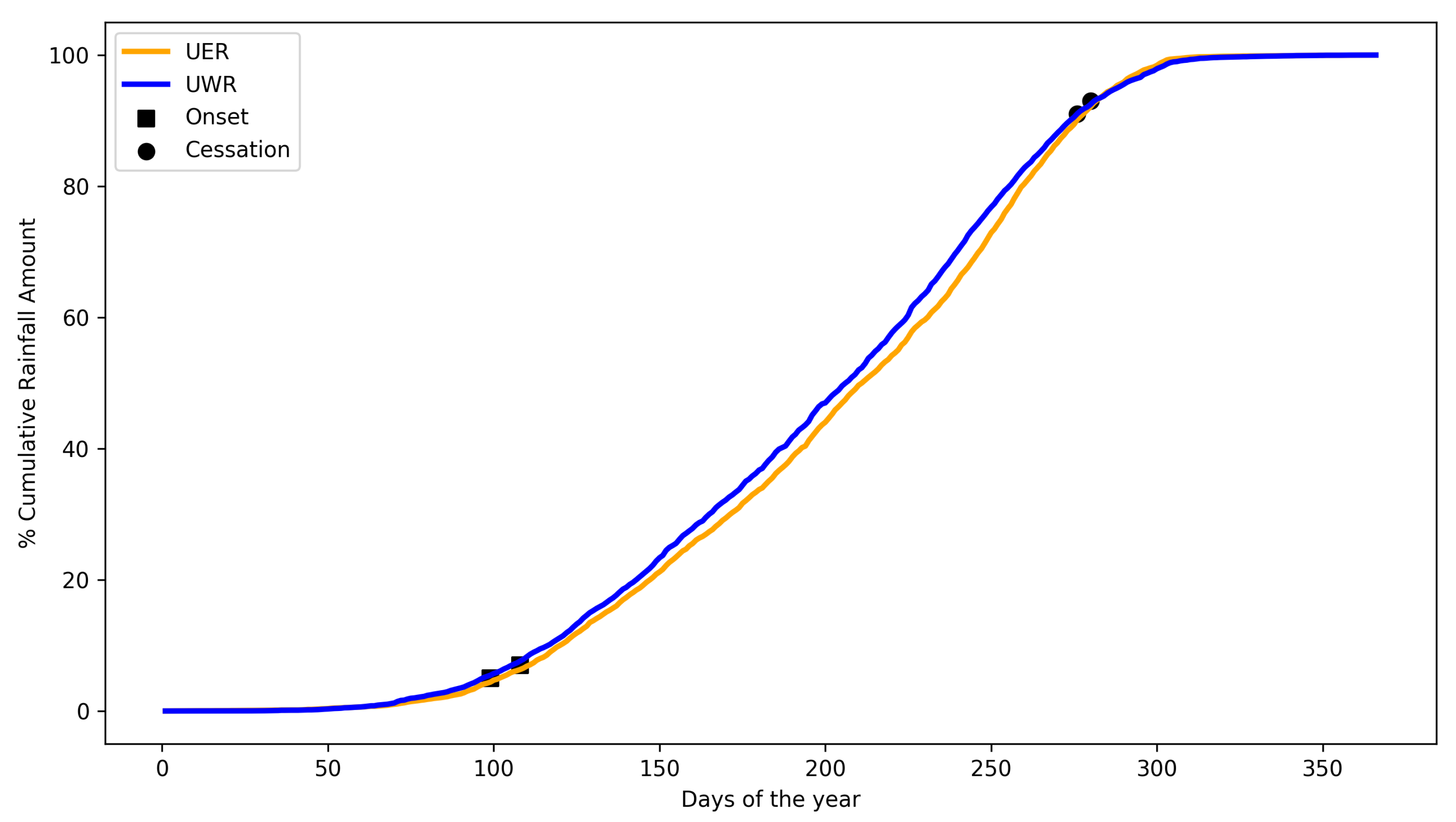

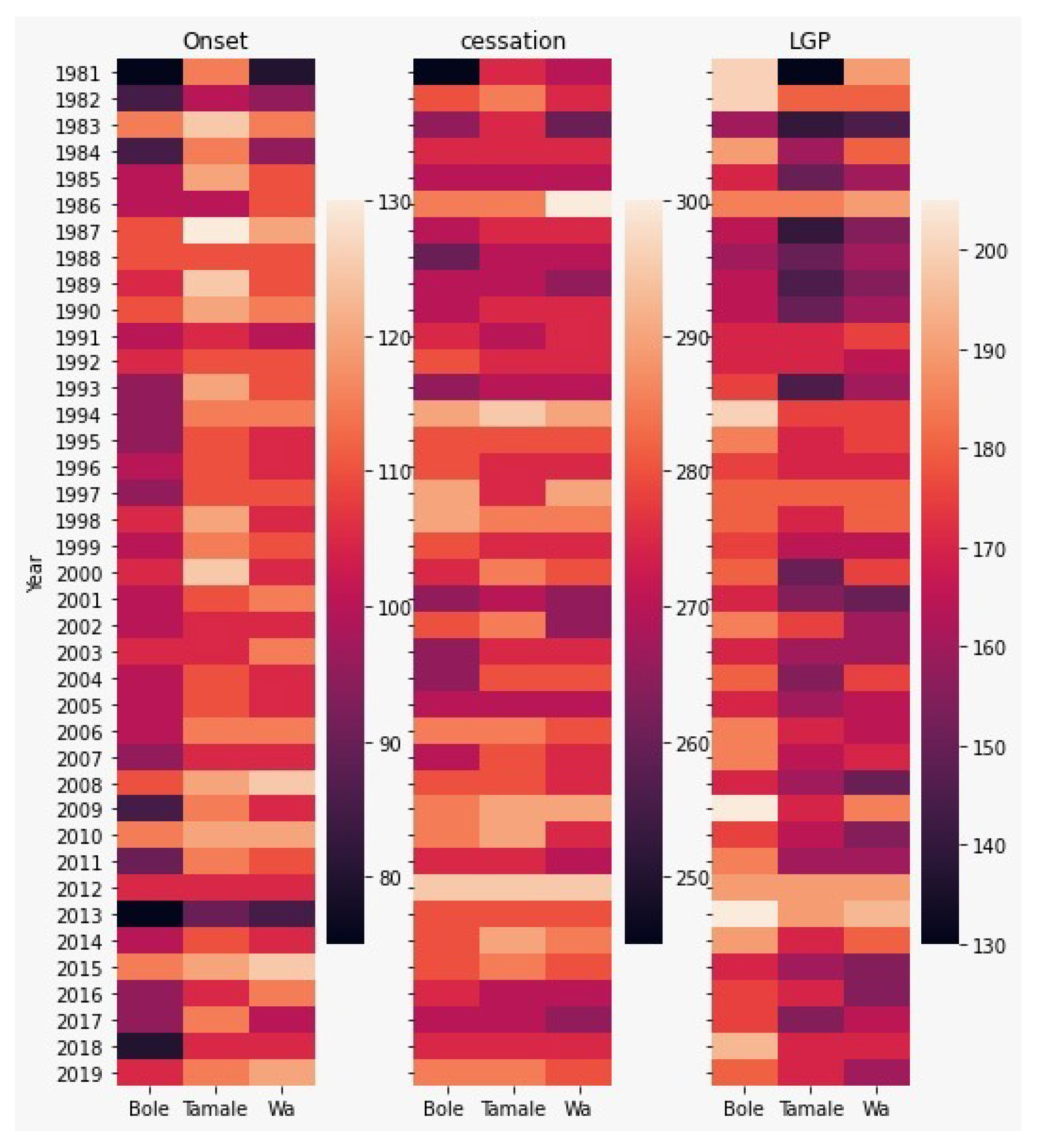
References
- Harrison, L.; Funk, C.; Peterson, P. Identifying changing precipitation extremes in Sub-Saharan Africa with gauge and satellite products. Environ. Res. Lett. 2019, 14, 085007. [Google Scholar] [CrossRef]
- Atiah, W.A.; Amekudzi, L.K.; Akum, R.A.; Quansah, E.; Antwi-Agyei, P.; Danuor, S.K. Climate Variability and Impacts on Maize (Zea Mays) Yield in Ghana, West Africa. Available online: https://rmets.onlinelibrary.wiley.com/doi/full/10.1002/qj.4199 (accessed on 1 December 2021).
- Adhikari, U.; Nejadhashemi, A.P.; Woznicki, S.A. Climate change and eastern Africa: A review of impact on major crops. Food Energy Secur. 2015, 4, 110–132. [Google Scholar] [CrossRef]
- Ray, D.K.; Gerber, J.S.; MacDonald, G.K.; West, P.C. Climate variation explains a third of global crop yield variability. Nat. Commun. 2015, 6, 1–9. [Google Scholar] [CrossRef] [Green Version]
- Atiah, W.A.; Tsidu, G.M.; Amekudzi, L.; Yorke, C. Trends and interannual variability of extreme rainfall indices over Ghana, West Africa. Theor. Appl. Climatol. 2020, 140, 1393–1407. [Google Scholar] [CrossRef]
- Muthoni, F. Spatial-temporal trends of rainfall, maximum and minimum temperatures over west Africa. IEEE J. Sel. Top. Appl. Earth Obs. Remote Sens. 2020, 13, 2960–2973. [Google Scholar] [CrossRef]
- Liebmann, B.; Marengo, J. Interannual variability of the rainy season and rainfall in the Brazilian Amazon Basin. J. Clim. 2001, 14, 4308–4318. [Google Scholar] [CrossRef] [Green Version]
- Liebmann, B.; Bladé, I.; Kiladis, G.N.; Carvalho, L.M.; Senay, G.B.; Allured, D.; Leroux, S.; Funk, C. Seasonality of African precipitation from 1996 to 2009. J. Clim. 2012, 25, 4304–4322. [Google Scholar] [CrossRef]
- Akinseye, F.M.; Agele, S.O.; Traore, P.; Adam, M.; Whitbread, A.M. Evaluation of the onset and length of growing season to define planting date—‘A case study for Mali (West Africa)’. Theor. Appl. Climatol. 2016, 124, 973–983. [Google Scholar] [CrossRef] [Green Version]
- Dunning, C.M.; Black, E.C.; Allan, R.P. The onset and cessation of seasonal rainfall over Africa. J. Geophys. Res. Atmos. 2016, 121, 11–405. [Google Scholar] [CrossRef] [Green Version]
- Amekudzi, L.K.; Yamba, E.I.; Preko, K.; Asare, E.O.; Aryee, J.; Baidu, M.; Codjoe, S.N. Variabilities in rainfall onset, cessation and length of rainy season for the various agro-ecological zones of Ghana. Climate 2015, 3, 416–434. [Google Scholar] [CrossRef]
- Gbangou, T.; Ludwig, F.; van Slobbe, E.; Hoang, L.; Kranjac-Berisavljevic, G. Seasonal variability and predictability of agro-meteorological indices: Tailoring onset of rainy season estimation to meet farmers’ needs in Ghana. Clim. Serv. 2019, 14, 19–30. [Google Scholar] [CrossRef]
- MacLeod, D. Seasonal predictability of onset and cessation of the east African rains. Weather Clim. Extrem. 2018, 21, 27–35. [Google Scholar] [CrossRef]
- Vellinga, M.; Arribas, A.; Graham, R. Seasonal forecasts for regional onset of the West African monsoon. Clim. Dyn. 2013, 40, 3047–3070. [Google Scholar] [CrossRef] [Green Version]
- Antwi-Agyei, P.; Fraser, E.D.; Dougill, A.J.; Stringer, L.C.; Simelton, E. Mapping the vulnerability of crop production to drought in Ghana using rainfall, yield and socioeconomic data. Appl. Geogr. 2012, 32, 324–334. [Google Scholar] [CrossRef]
- Baidu, M.; Amekudzi, L.K.; Aryee, J.N.; Annor, T. Assessment of long-term spatio-temporal rainfall variability over Ghana using wavelet analysis. Climate 2017, 5, 30. [Google Scholar] [CrossRef] [Green Version]
- Boansi, D.; Tambo, J.A.; Müller, M. Intra-seasonal risk of agriculturally-relevant weather extremes in West African Sudan Savanna. Theor. Appl. Climatol. 2019, 135, 355–373. [Google Scholar] [CrossRef]
- Laux, P.; Kunstmann, H.; Bárdossy, A. Predicting the regional onset of the rainy season in West Africa. Int. J. Climatol. J. R. Meteorol. Soc. 2008, 28, 329–342. [Google Scholar] [CrossRef] [Green Version]
- Chemura, A.; Schauberger, B.; Gornott, C. Impacts of climate change on agro-climatic suitability of major food crops in Ghana. PLoS ONE 2020, 15, e0229881. [Google Scholar] [CrossRef]
- Owusu Danquah, E.; Beletse, Y.; Stirzaker, R.; Smith, C.; Yeboah, S.; Oteng-Darko, P.; Frimpong, F.; Ennin, S.A. Monitoring and Modelling Analysis of Maize (Zea mays L.) Yield Gap in Smallholder Farming in Ghana. Agriculture 2020, 10, 420. [Google Scholar] [CrossRef]
- Mkonda, M.Y.; He, X. Climate variability and crop yields synergies in Tanzania’s semiarid agroecological zone. Ecosyst. Health Sustain. 2018, 4, 59–72. [Google Scholar] [CrossRef] [Green Version]
- Ocen, E.; de Bie, C.; Onyutha, C. Investigating False start of the Main Growing Season: A Case of Uganda in East Africa. Available online: https://www.sciencedirect.com/science/article/pii/S2405844021025317 (accessed on 1 December 2021).
- Van de Giesen, N.; Liebe, J.; Jung, G. Adapting to climate change in the Volta Basin, West Africa. Curr. Sci. 2010, 98, 1033–1037. [Google Scholar]
- Sarku, R.; Dewulf, A.; van Slobbe, E.; Termeer, K.; Kranjac-Berisavljevic, G. Adaptive decision-making under conditions of uncertainty: The case of farming in the Volta delta, Ghana. J. Integr. Environ. Sci. 2020, 17, 1–33. [Google Scholar] [CrossRef] [Green Version]
- Shukla, S.; Husak, G.; Turner, W.; Davenport, F.; Funk, C.; Harrison, L.; Krell, N. A slow rainy season onset is a reliable harbinger of drought in most food insecure regions in Sub-Saharan Africa. PLoS ONE 2021, 16, e0242883. [Google Scholar] [CrossRef]
- Dinku, T. Challenges with availability and quality of climate data in Africa. In Extreme Hydrology and Climate Variability; Elsevier: Amsterdam, The Netherlands, 2019; pp. 71–80. [Google Scholar]
- Contractor, S.; Donat, M.G.; Alexander, L.V.; Ziese, M.; Meyer-Christoffer, A.; Schneider, U.; Rustemeier, E.; Becker, A.; Durre, I.; Vose, R.S. Rainfall Estimates on a Gridded Network (REGEN)—A global land-based gridded dataset of daily precipitation from 1950 to 2016. Hydrol. Earth Syst. Sci. 2020, 24, 919–943. [Google Scholar] [CrossRef] [Green Version]
- Salerno, J.; Diem, J.E.; Konecky, B.L.; Hartter, J. Recent intensification of the seasonal rainfall cycle in equatorial Africa revealed by farmer perceptions, satellite-based estimates, and ground-based station measurements. Clim. Chang. 2019, 153, 123–139. [Google Scholar] [CrossRef]
- Darabant, A.; Habermann, B.; Sisay, K.; Thurnher, C.; Worku, Y.; Damtew, S.; Lindtner, M.; Burrell, L.; Abiyu, A. Farmers’ perceptions and matching climate records jointly explain adaptation responses in four communities around Lake Tana, Ethiopia. Clim. Chang. 2020, 163, 481–497. [Google Scholar] [CrossRef]
- Antwi-Agyei, P.; Dougill, A.J.; Stringer, L.C.; Codjoe, S.N.A. Adaptation opportunities and maladaptive outcomes in climate vulnerability hotspots of northern Ghana. Clim. Risk Manag. 2018, 19, 83–93. [Google Scholar] [CrossRef]
- Diem, J.E.; Hartter, J.; Salerno, J.; McIntyre, E.; Grandy, A.S. Comparison of measured multi-decadal rainfall variability with farmers’ perceptions of and responses to seasonal changes in western Uganda. Reg. Environ. Chang. 2017, 17, 1127–1140. [Google Scholar] [CrossRef]
- Esayas, B.; Simane, B.; Teferi, E.; Ongoma, V.; Tefera, N. Climate variability and farmers’ perception in southern Ethiopia. Adv. Meteorol. 2019, 2019, 7341465. [Google Scholar] [CrossRef]
- Guodaar, L.; Bardsley, D.K.; Suh, J. Integrating local perceptions with scientific evidence to understand climate change variability in northern Ghana: A mixed-methods approach. Appl. Geogr. 2021, 130, 102440. [Google Scholar] [CrossRef]
- Atiah, W.A.; Amekudzi, L.K.; Quansah, E.; Preko, K. The spatio-temporal variability of rainfall over the agro-ecological zones of Ghana. Atmos. Clim. Sci. 2019, 4, 527–544. [Google Scholar] [CrossRef] [Green Version]
- Funk, C.; Peterson, P.; Landsfeld, M.; Pedreros, D.; Verdin, J.; Shukla, S.; Husak, G.; Rowland, J.; Harrison, L.; Hoell, A.; et al. The climate hazards infrared precipitation with stations—A new environmental record for monitoring extremes. Sci. Data 2015, 2, 1–21. [Google Scholar] [CrossRef] [Green Version]
- Atiah, W.A.; Amekudzi, L.K.; Aryee, J.N.A.; Preko, K.; Danuor, S.K. Validation of satellite and merged rainfall data over Ghana, West Africa. Atmosphere 2020, 11, 859. [Google Scholar] [CrossRef]
- Atiah, W.A.; Tsidu, G.M.; Amekudzi, L.K. Investigating the merits of gauge and satellite rainfall data at local scales in Ghana, West Africa. Weather. Clim. Extrem. 2020, 30, 100292. [Google Scholar] [CrossRef]
- Theil, H. A rank-invariant method of linear and polynomial regression analysis. Indag. Math. 1950, 12, 173. [Google Scholar]
- Mann, H.B. Nonparametric tests against trend. Econom. J. Econom. Soc. 1945, 13, 245–259. [Google Scholar] [CrossRef]
- Kendall, K. Thin-film peeling-the elastic term. J. Phys. D Appl. Phys. 1975, 8, 1449. [Google Scholar] [CrossRef]
- Spearman, C. The proof and measurement of association between two things. Am. J. Psychol. 1987, 100, 441–471. [Google Scholar] [CrossRef]
- Lehmann, E.L.; D’Abrera, H.J. Nonparametrics: Statistical Methods Based on Ranks; Holden-Day: Hoboken, NJ, USA, 1975; Available online: https://rss.onlinelibrary.wiley.com/doi/abs/10.2307/2344536 (accessed on 10 May 2021).
- Onyutha, C. Graphical-statistical method to explore variability of hydrological time series. Hydrol. Res. 2021, 52, 266–283. [Google Scholar] [CrossRef]
- Onyutha, C. Statistical uncertainty in hydrometeorological trend analyses. Adv. Meteorol. 2016, 2016, 266–283. [Google Scholar] [CrossRef] [Green Version]
- Wood, A.W.; Leung, L.R.; Sridhar, V.; Lettenmaier, D. Hydrologic implications of dynamical and statistical approaches to downscaling climate model outputs. Clim. Chang. 2004, 62, 189–216. [Google Scholar] [CrossRef]
- Kimani, M.W.; Hoedjes, J.C.; Su, Z. Bayesian bias correction of satellite rainfall estimates for climate studies. Remote Sens. 2018, 10, 1074. [Google Scholar] [CrossRef] [Green Version]
- Dakurah, G. How do farmers’ perceptions of climate variability and change match or and mismatch climatic data? Evidence from North-west Ghana. GeoJournal 2021, 86, 2387–2406. [Google Scholar] [CrossRef]
- Roncoli, C.; Ingram, K.; Kirshen, P. Reading the rains: Local knowledge and rainfall forecasting in Burkina Faso. Soc. Nat. Resour. 2002, 15, 409–427. [Google Scholar] [CrossRef]
- DONKOH, S.A. Farmers’ willingness-to-pay for weather information through mobile phones in northern Ghana. Ghana J. Sci. Technol. Dev. 2019, 6, 19–36. [Google Scholar] [CrossRef]


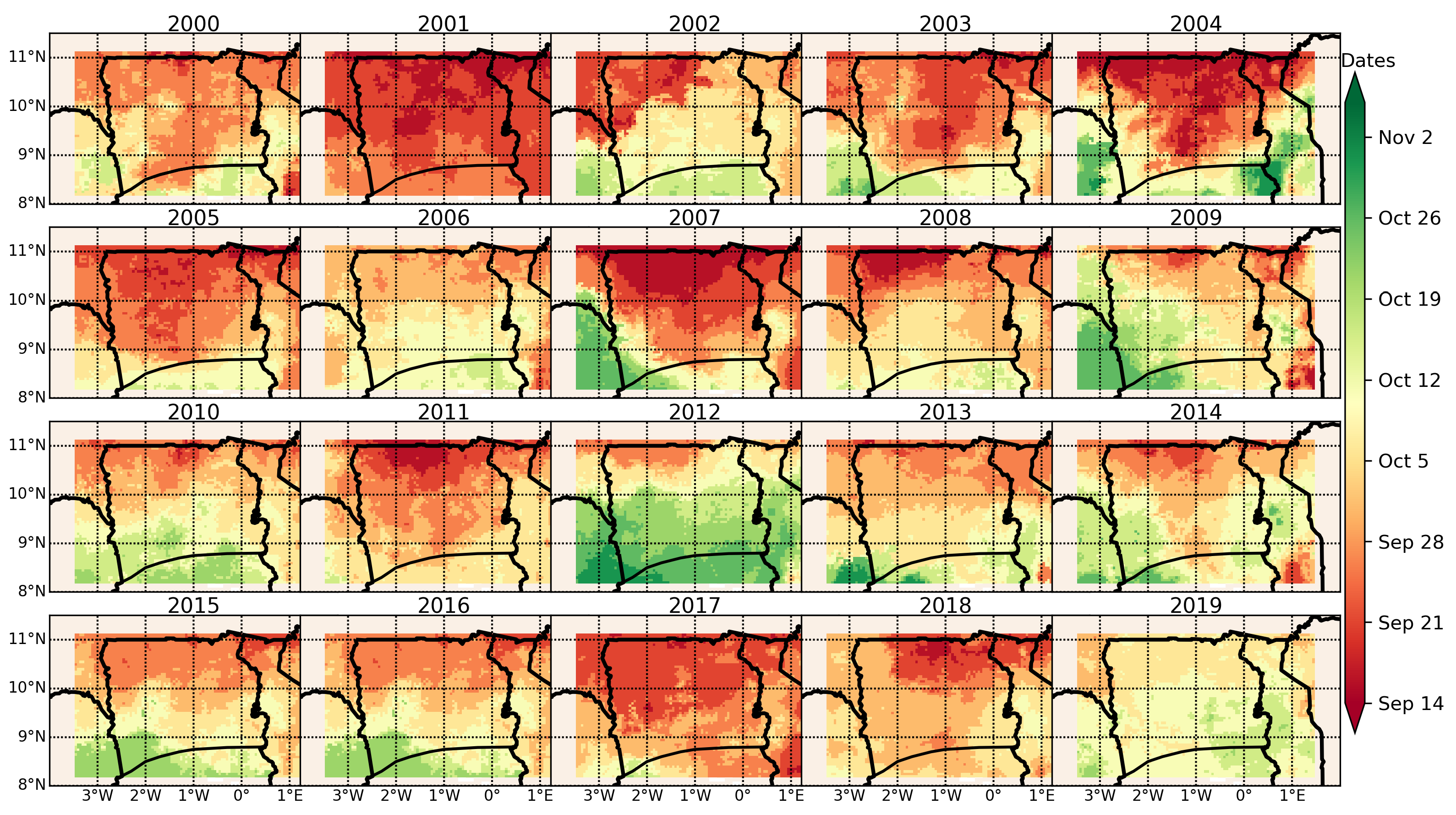


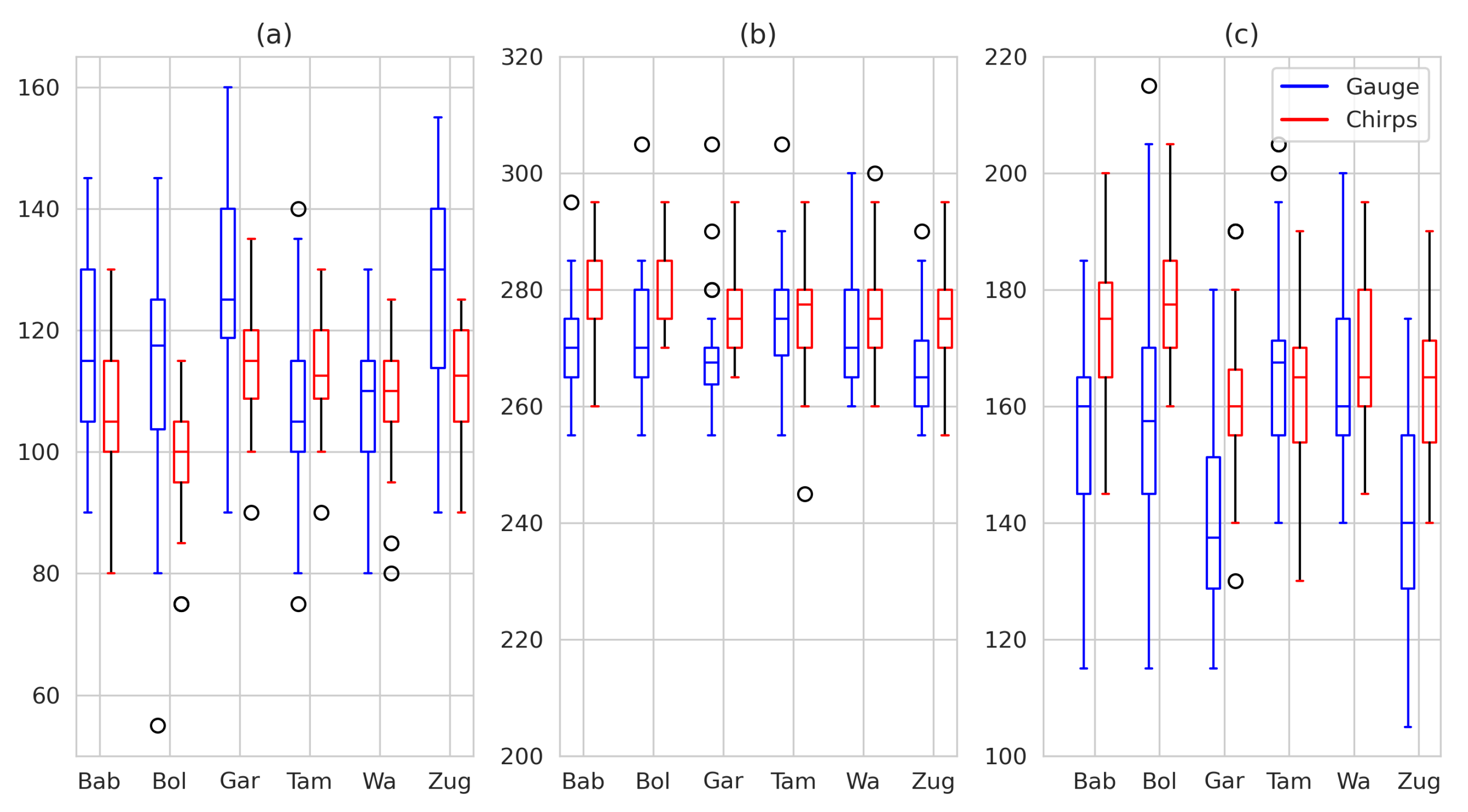
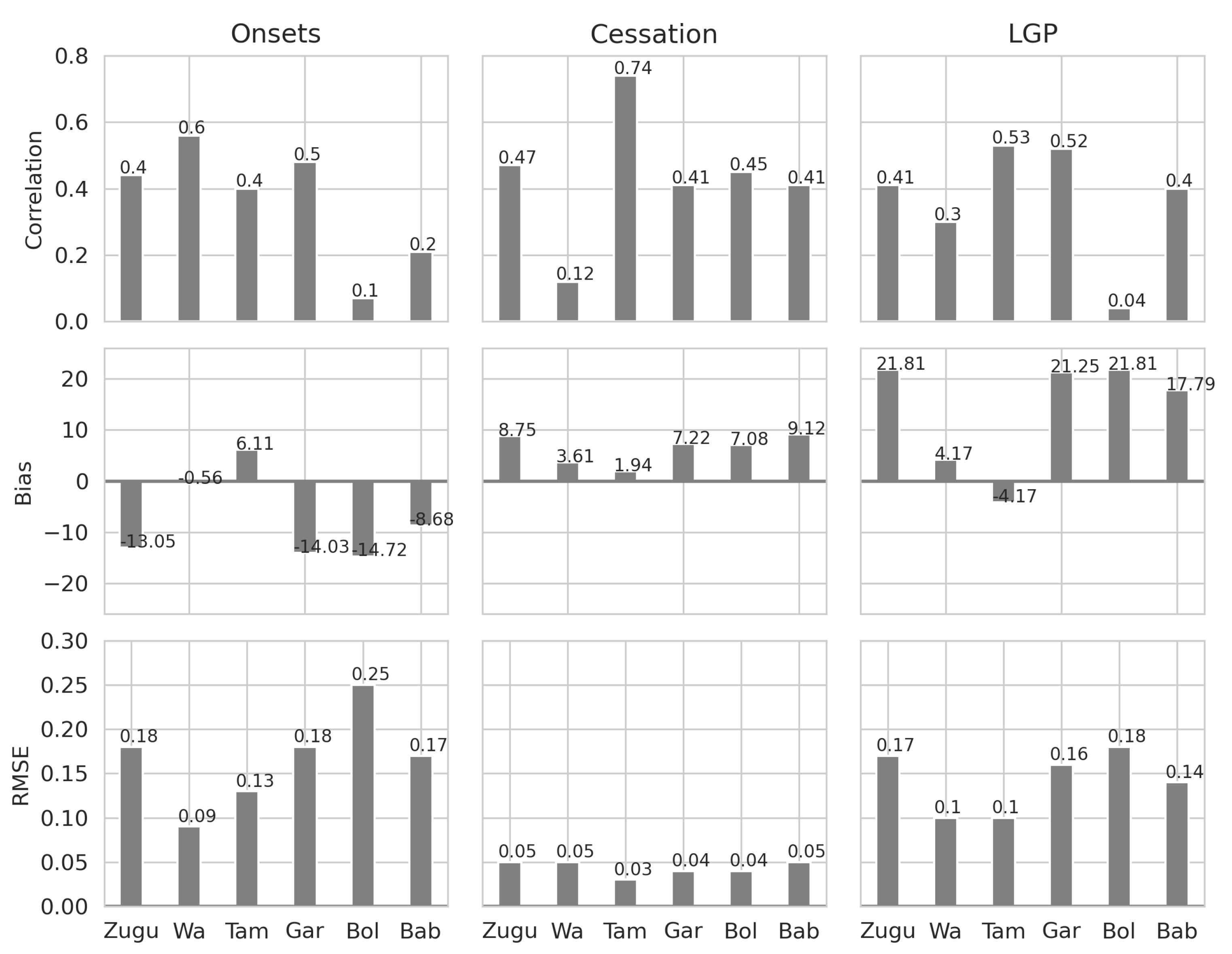


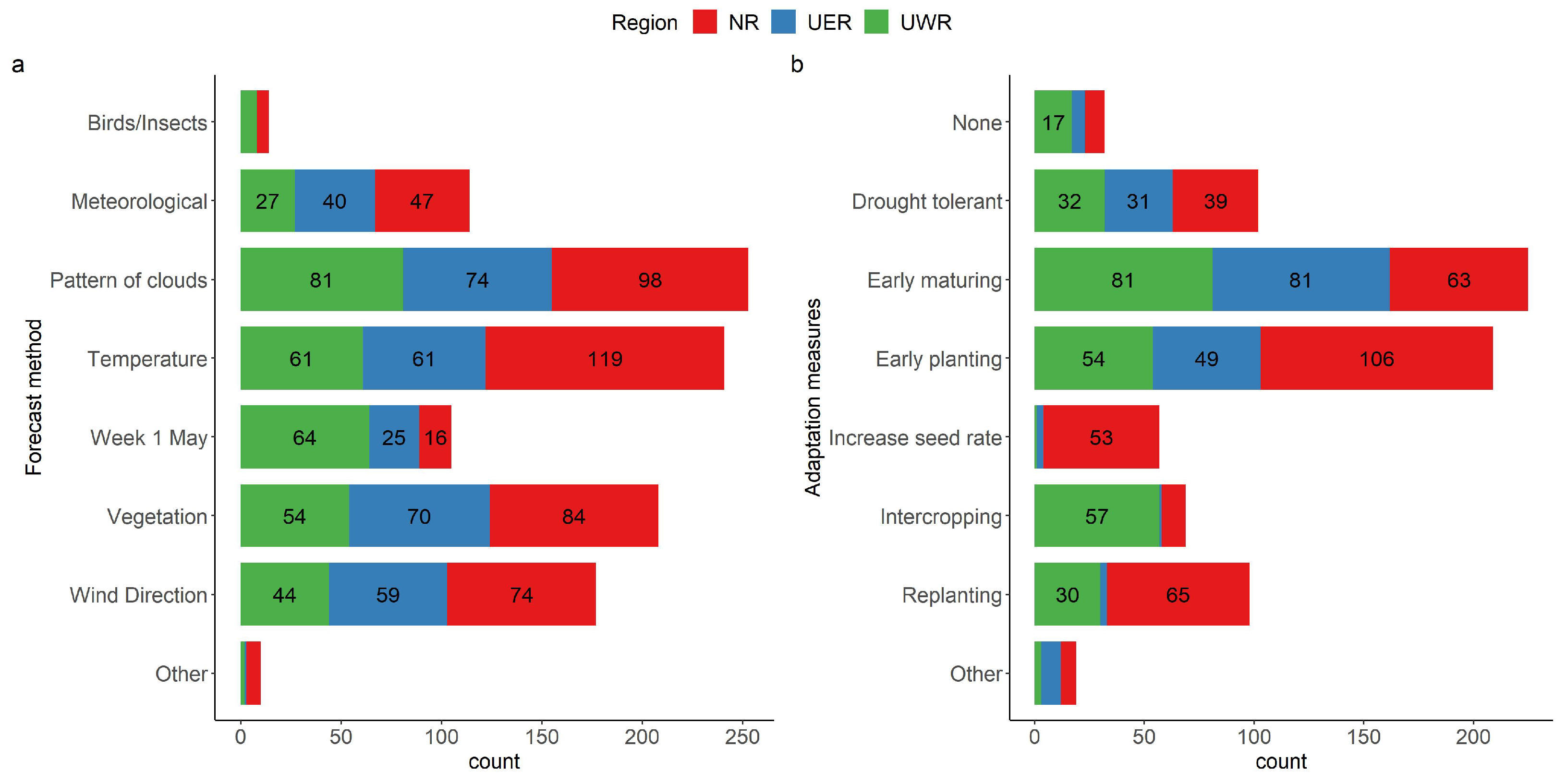
| ID | Parameter | Choices |
|---|---|---|
| 1 | Sex | 1 = Male |
| 2 = Female | ||
| 2 | Age | Age of respondent |
| 3 | Educational Level | 0 = Informal |
| 1 = Primary | ||
| 2 = Secondary | ||
| 3 = Certificate | ||
| 4 = Diploma | ||
| 5 = Bachelor | ||
| 6 = Masters or above | ||
| 7 = Others (specify) | ||
| 4 | Main economic activity | 1 = Crop Farming |
| 2 = Livestock Farming | ||
| 3 = Fishing | ||
| 4 = Formal Employment | ||
| 5 = Petty business | ||
| 6 = Others (specify) | ||
| 5 | Main Crop | Maize |
| Groundnuts | ||
| Cowpea | ||
| Soybean | ||
| 6 | Onset/Cessation trend | Same |
| Early | ||
| Late | ||
| 7 | Method of forecasting rainfall onset | Birds/insect movements |
| Meteorological agency | ||
| Pattern of clouds | ||
| Change in temperature | ||
| Traditionally first week of May | ||
| Vegetation phenology | ||
| Wind direction | ||
| Other (specify) | ||
| 8 | Importance of onset on yield of the main crop | Somehow important |
| Important | ||
| Very important | ||
| 9 | Replant frequency due to false onset of rainfall | Never |
| Once | ||
| Twice | ||
| Thrice | ||
| Four times | ||
| Five times | ||
| 10 | Adaptation measures | None |
| Drought-tolerant cultivars | ||
| Early maturing cultivars | ||
| Increase seed rate | ||
| Intercropping | ||
| Replanting | ||
| Other (specify) |
| Region | Gauge Station | Correlation Gauge vs. Satellite (r) | Satellite | Gauge | Farmer’s Perceptions |
|---|---|---|---|---|---|
| Onset | |||||
| UER | Zuarungu | 0.44 | Early | Early | Late |
| UWR | Wa | 0.57 | Early | Late | Late |
| NR | Tamale | 0.40 | Early | Early | Early |
| Cessation | |||||
| UER | Zuarungu | 0.40 | Late | Late | Early |
| UWR | Wa | 0.10 | Early | Early | Early |
| NR | Tamale | 0.74 | Late | Late | Divergent |
Publisher’s Note: MDPI stays neutral with regard to jurisdictional claims in published maps and institutional affiliations. |
© 2021 by the authors. Licensee MDPI, Basel, Switzerland. This article is an open access article distributed under the terms and conditions of the Creative Commons Attribution (CC BY) license (https://creativecommons.org/licenses/by/4.0/).
Share and Cite
Atiah, W.A.; Muthoni, F.K.; Kotu, B.; Kizito, F.; Amekudzi, L.K. Trends of Rainfall Onset, Cessation, and Length of Growing Season in Northern Ghana: Comparing the Rain Gauge, Satellite, and Farmer’s Perceptions. Atmosphere 2021, 12, 1674. https://doi.org/10.3390/atmos12121674
Atiah WA, Muthoni FK, Kotu B, Kizito F, Amekudzi LK. Trends of Rainfall Onset, Cessation, and Length of Growing Season in Northern Ghana: Comparing the Rain Gauge, Satellite, and Farmer’s Perceptions. Atmosphere. 2021; 12(12):1674. https://doi.org/10.3390/atmos12121674
Chicago/Turabian StyleAtiah, Winifred Ayinpogbilla, Francis K. Muthoni, Bekele Kotu, Fred Kizito, and Leonard K. Amekudzi. 2021. "Trends of Rainfall Onset, Cessation, and Length of Growing Season in Northern Ghana: Comparing the Rain Gauge, Satellite, and Farmer’s Perceptions" Atmosphere 12, no. 12: 1674. https://doi.org/10.3390/atmos12121674
APA StyleAtiah, W. A., Muthoni, F. K., Kotu, B., Kizito, F., & Amekudzi, L. K. (2021). Trends of Rainfall Onset, Cessation, and Length of Growing Season in Northern Ghana: Comparing the Rain Gauge, Satellite, and Farmer’s Perceptions. Atmosphere, 12(12), 1674. https://doi.org/10.3390/atmos12121674






